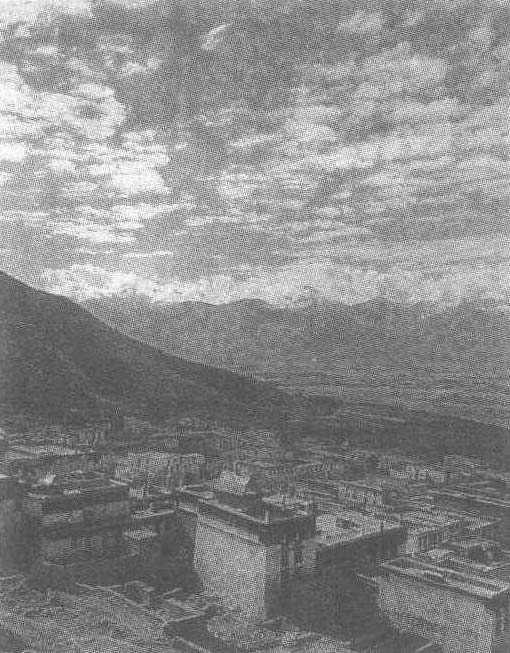色拉寺
藏传佛教格鲁派六大寺院之一。在今西藏拉萨市北郊色拉山麓。明永乐十二年(1414),宗喀巴弟子绛钦却杰赴京朝见皇帝,被封为大国师。回藏后于永乐十六年创建此寺。宣德九年(1434),该寺建成,绛钦却杰应召入京,被封为大慈法王,钦赐用泥金书写的《大般若经》、朱砂书写的大藏经、檀香木雕的十六罗汉像、金汁画的释迦牟尼转法轮画、缂丝织的大慈法王像及法器、供器等文物。寺历经扩建,规模宏大。寺内有措钦大殿和结巴、麦巴、阿巴三个扎仓(学院)。17世纪,寺僧定数5500人; 1949年即达9000人。与哲蚌寺、甘丹寺合称拉萨三大寺。1982年公布为全国重点文物保护单位。
色拉寺
在西藏自治区拉萨市北郊培不切山脚。明永乐十七年(公元1419年)宗喀巴弟子绛青曲结创建,以后又多次增修。寺内设有三个扎仓(经学院),可容纳僧众5千人。措钦大殿是全寺最大的殿堂,由经堂和五个拉康(佛殿)组成。吉扎仓是寺内规模最大的扎仓,初建于公元1435年,仅经堂就有100根柱子,经堂的西、北部还有五个佛殿。寺内存有绛青曲结从北京带回的藏文《甘珠尔经》和旃檀木雕16罗汉像一套。色拉寺规模宏大,僧舍密布,错落有致。由于建筑材料色彩相同,具有统一全局的作用,加上优美的环境,如同一座宗教城市一般,此寺与甘丹寺、哲蚌寺合称西藏三大寺,为全国重点文物保护单位。

色拉寺
色拉,藏语意为“冰雹”,据说该寺奠基时,正下冰雹。色拉寺是西藏三大黄教寺院最后兴建的一座大寺,与噶丹寺、哲蚌寺不同,该寺不是建在山上,而是建在拉萨市城北部的乌孜山脚下。1418年(明永乐十六年)始建,到1419年全部建成。
该寺是由宗喀巴八大弟子之一释迦益协主持修建的。释迦益协是一位佛教大师,曾进京讲授佛经,并赴蒙古传经,进京后受明代宣德皇帝晋奉为“国师”,宣德九年他再次进京,被宣宗留作了御用喇嘛。他从京城带回来许多由皇帝送的礼物,至今还收藏在该寺。
寺内还有一个很大的讲经厅,该厅分32个部分,可容纳10000余名僧侣,在明代时是被引以为自豪的寺院。色拉寺有上万个西藏本地制作的金刚像,还有许多从印度带来的铜佛像。该寺1982年2月被国务院列为全国重点文物保护单位。
单位:拉萨市色拉寺管理处 邮编:850000
电话:86-891-6323139
色拉寺
藏传佛寺。在西藏拉萨市北郊。创建于明永乐十七年(1419)。永乐七年(1409)宗喀巴弟子降青曲结代表宗喀巴进京朝觐,带回金写藏文大藏经一部,还有佛像及旃檀木雕十六尊者像等。回藏后为了供奉皇帝所赐之物,特建色拉寺。后经多次增修扩建,规模恢宏,建筑雄伟,殿堂内雕塑精致,壁画优美,色彩绚丽。寺内设有显宗经学院2个 (结巴扎仓、麦巴扎仓),密宗经学院一个 (鄂巴扎仓)。僧人最多时达8000人。明宣德九年(1434) 明廷封降青曲结为 “万行妙明真如上胜清净般若弘愿普慧辅国显教至善大慈法王西天正觉如来自在大圆通佛”。简称 “大慈法王”。并编织大慈法王缂丝像一幅送给西藏,现存色拉寺。色拉寺与甘丹寺、哲蚌寺合称拉萨三大寺 是全国重点文物单位。
色拉寺
全国重点文物保护单位。位于市东北郊色拉乌孜山南麓。明永乐十六年(1418)宗喀巴弟子绛青曲结所建,与哲蚌寺、甘丹寺合称“三大寺”。据说黄教始祖宗喀巴一日经过此处酸果林,所乘马无故三鸣,遂预言三年后“马头金刚”将降临于此,于是命弟子建寺,供奉马头金刚。酸果林,藏语为色拉,寺因名。寺背山面阳,层层递高。清人孙士毅《色拉寺》诗云:“金殿晃朝日,宝气凌绀宇。层楼耸花宫,天半轶云雨。”全寺占地面积约11.5万平方米,由措钦大殿、3个扎仓(大经堂)、30个康村(寺庙组织)组成。佛殿、僧舍依山势起伏,错落有致,建筑规模宏壮,寺景清幽。大殿藏式平顶上冠以汉式歇山屋顶,覆以鎏金铜瓦,饰以宝盘、宝珠、神鸟、倒幢等。檐下置汉式建筑斗拱。殿堂内有铜铸佛像,近似印度风格。寺内有上万金刚佛像,均为本地制作。还收藏一部明永乐七年(1409)由绛青曲结从北京带回的朱砂写成的藏文《甘珠尔经》,一套旃檀木雕十六罗汉像、一幅明代内地织的大慈法王(绛青曲结封号)缂丝像,及大量未经重描的明代壁画,均属十分珍贵而精美的历史文物。
色拉寺
喇嘛教格鲁派(黄教)寺院,西藏三大寺之一。在拉萨北郊山脚下。明永乐十六年(1418年)由格鲁派创始人宗喀巴的弟子绛饮却杰兴建。全寺分结巴、麦巴、阿巴三个扎仓(经学院),僧人定额为5500人。大殿内壁画精美,佛像高大,其中弥勒佛和菩萨像雕刻工艺精湛细腻。寺内所藏的绛饮却杰自北京带回的金汁书写的《大藏经》一部和旃檀木雕十六尊者像一套,内地所织的大慈法王(即绛饮却杰)缂丝像等文物,极为珍贵。为全国重点文物保护单位。
色拉寺
喇嘛教格鲁派(黄教)寺院,西藏三大寺之一。在拉萨北郊山脚下。明永乐十六年(1418)由格鲁派创始人宗喀巴的弟子绛钦却杰(《明史》称“释迦也失”,1434年受封为*大慈法王)主持兴建。寺内有错钦大殿和结巴、麦巴、阿巴三个扎仓以及下属二十九个康村, 曾规定僧人名额为五千五百人。大殿内壁画优美,佛像高大, 其中弥勒佛和八菩萨像雕刻尤为精细古朴。寺内保存有绛钦却杰自北京带回的用金汁书写的藏文大藏经一部和旃檀木雕十六尊者像一套, 还有不少明、清两代的挂幛、“唐卡”(卷轴画),其中一幅内地织的大慈法王缂丝像, 极为珍贵,具有很高的艺术价值。
色拉寺
中国藏传佛教寺院。位于西藏拉萨东北郊。1419年释迦也失主持创建。主要建筑有措钦大殿、3个扎仓(经学院)和康村等。1709年兴建的措钦大殿,面积为1092 m2。显宗2个(结巴扎仓、麦巴扎仓)、密宗1个(鄂巴扎仓),曾有僧侣8000余人。藏传佛教格鲁派三大寺之一。